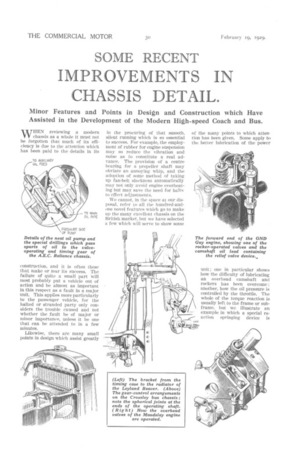SOME RECENT
Page 120

Page 121

If you've noticed an error in this article please click here to report it so we can fix it.
IMPROVEMENTS IN CHASSIS DETAIL.
Minor Features and Points in Design and Construction which Have Assisted in the Development of the Modern High-speed Coach and Bus.
WHEN reviewing a modern chassis as a whole it must not be forgotten that much of its efficiency is due to the attention which has been paid to the details in its
construction, and it is often these that make or mar its success. The failure of quite a small part will most probably put a vehicle out of action and be almost as important in this respect as a fault in a major unit. This applies more particularly to the passenger vehicle, for the halted or stranded party only considers the trouble caused and not whether the fault be of major or minor importance, unless it be one that can be attended to in a few minutes.
Likewise, there are many small points in design which assist greatly in the procuring of that smooth, silent running which is so essential to success. For example, the employment of rubber for engine suspension may so reduce the vibration and noise as to constitute a real advance. The provision of a centre bearing for a propeller shaft may obviate an annoying whip, and the adoption of some method of taking up fan-belt slackness automatically may not only avoid engine overheating but may save the need for halts to effect adjustments.
We cannot, in the space at our disposal, refer to all the hundred-andone novel features which go to make up the many excellent chassis on the British market, but we have selected a few which will serve to show some of the many points to which atten. tion has been given. Some apply to the better lubrication of the power unit; one in particular shows how the difficulty of lubricating an overhead camshaft and rockers has been overcome ; another, how the oil pressure is controlled by the throttle. The whole of the torque reaction is usually left to the frame or subframe, but we illustrate an example in which a special reaction springing device is utilized, A practice which is likely to become more popular in future is the carrying of the radiator as part of the engine unit, thus avoiding the racking which is so prevalent and which is liable to result in fracture and leakage.
There are certain points which we have not illustrated but to which more and more attention is being given. There is, for example, the Lendelicy towards the centralizing of chassis lubrication. At the moment we have not quite reached the stage of the " one shot." but, in many instances, the lubricating points are being connected to batteries of nipples, conveniently arranged so that ready access can be had to them, even with the body in position. We regard this matter as being of considerable importance, as it greatly reduces the labour of maintenance and the possibility of very costly neglect.




























































































































































































































